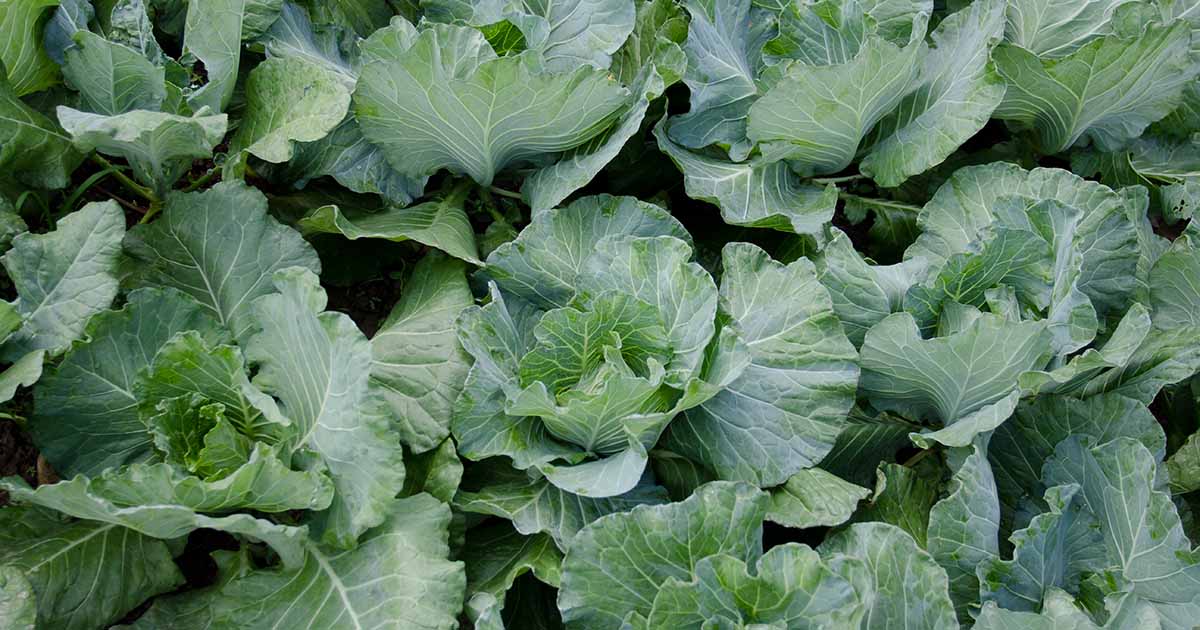This is a difficult insect to deal with, as it has developed resistance to some pesticides. Natural predators include the parasitic wasp, a beneficial insect.
You can treat with neem oil or Bt, but you may find them to be ineffective.
You can also try a practice called “trap cropping,” as recommended by T. Jude Boucher, vegetable crops IPM coordinator at the University of Connecticut.
It involves planting a barrier of another plant the pest likes around your brassica. In this case, collard greens are recommended.
The idea is that these moths will chew the collards to bits before attacking your cauliflower. Best case scenario – you get to enjoy both crops at harvest time.
Read more about planting and using trap crops here.
4. Cabbage Root Maggots
This root maggot, Delia radicum, is the larva of the cabbage root fly.
This tiny brown fly lays minute, 1/8-inch eggs that contain white larvae, or maggots. When they hatch, the maggots feed on the roots of brassica crops.


If you see an inordinate number of tiny flies around your crops, apply diatomaceous earth to the soil over the roots to discourage egg laying.
And if your plants are showing signs of distress, dig down, examine the roots, and discard infested plants.


Alternatively, you may try an application of nematodes, Steinernema feltiae, which are microscopic worms that attack soilborne pests.
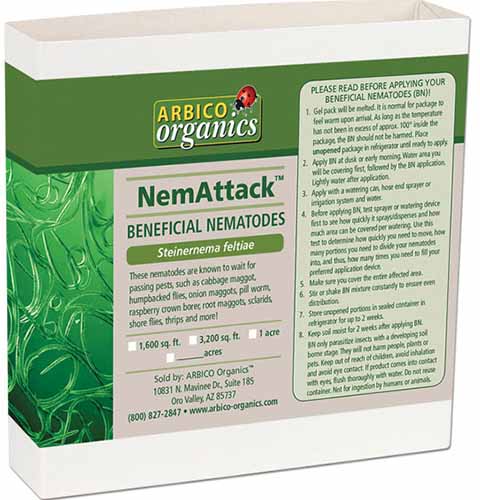

NemAttack Sf Beneficial Nematodes
Find NemAttack Sf Beneficial Nematodes from Arbico Organics in packages containing five, 10, 50, 250, or 500 million.
There’s something else you may want to try – a collar. This is a circle of felt, cardboard, or a similar material that goes around a plant at the soil level to prevent flies from laying eggs near the roots.
Find it in garden centers or make your own.
5. Cabbage White Butterflies
Pieris rapae lays yellow eggs on the undersides of brassica leaves. They contain larvae, or caterpillars, that are born with a voracious appetite.


Also called cabbage worms or green worms these caterpillars devour leaves and bore into heads, ruining entire crops.


Check your plants daily for caterpillars, and handpick and destroy any you find.
Alternatively, you can treat your plants with Bt or pyrethrin, the organic treatments of choice for dealing with this pest.
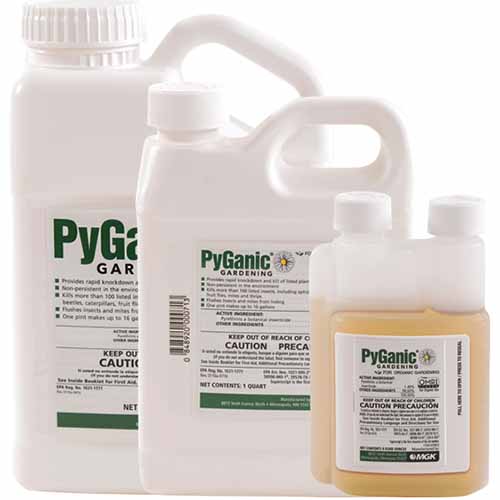

PyGanic Gardening Botanical Insecticide
PyGanic Gardening’s Botanical Insecticide Pyrethrin Concentrate for Organic Gardening is available from Arbico Organics in eight-ounce, 32-ounce, and gallon-sized bottles.
Read more about defeating the cabbage worm here.
6. Cabbage Whiteflies
Another pest you may see is the cabbage whitefly, Aleyrodes proletella.
This tiny white fly and its young scaly nymphs infest the undersides of leaves, feeding on leaf sap, and excreting “honeydew” that promotes sooty mold growth.


But while this type of whitefly disfigures a plant’s leaves, it doesn’t damage the heads, so many growers simply put up with it.
Experts at the Royal Horticultural Society are of the opinion that unless an infestation is severe, it probably doesn’t need to be addressed with pesticides.
However, if you go that route, know that treating the undersides of leaves is a temporary fix, and product instructions must be followed diligently with reference to selecting the right one for the right crop, as well as safe harvest intervals for application.
An organic approach to eradicating whiteflies includes introducing a beneficial insect to the vegetable patch, namely lacewings, Chrysoperla rufilabris.
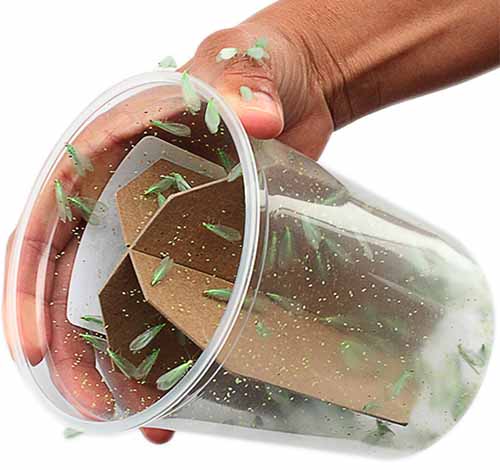

Adult Lacewings
Find lacewings now from Arbico Organics in packages containing 100, 250, or 500 pre-fed adults.
Adult lacewings feed on whiteflies as well as caterpillars, making them a valuable addition to the garden. They live for four to six weeks.
Read more about managing whiteflies here.
7. Cross-Striped Cabbage Worms
Per the pros at the University of Massachusetts, Amherst Center for Agriculture, Food, and the Environment, the cross-striped cabbage worm, Evergestis rimosalis, is easily distinguished from other brassica pests in the egg stage.
This is because it is the only species to lay eggs in clusters that look like flat yellow patches on the undersides of foliage.


The larva, or caterpillar, is blue-gray with black stripes on top, and solid green underneath.
It feeds on leaves and works its way into the heads before maturing into the brown moth with translucent lower wings that you may notice fluttering around your plants.
You can handpick the caterpillars when you see them, or you can be proactive with a biological control.
An effective course of action is the use of moth egg parasites, Trichogramma brassicae. These are parasitic wasps that feed on the eggs before they hatch.
This approach works best in the coolest regions. It involves a process of releasing the predators every week or so following the first appearance of the moths, so they are in place when the eggs are laid.
Tiny and non-stinging, these beneficial insects live for about two weeks.
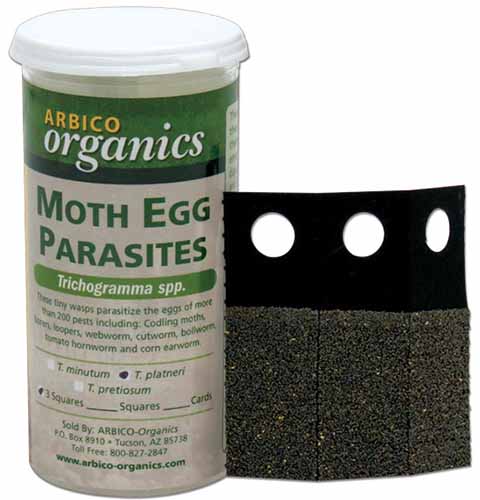

Moth Egg Parasites
Purchased wasps are shipped in the egg phase, attached to cards. You hang these up near the cauliflower plants, out of direct sunlight, where the moths are active. When they hatch, the wasps seek their prey.
Moth Egg Parasites are available from Arbico Organics in packages containing three tabs, six tabs, and a 30-tab card.
Take care not to touch the fragile eggs when placing the cards.
You can also treat an outbreak with an application of Bt or pyrethrin, the organic pesticides described earlier.
And you can also attract parasitic wasps to the garden with umbel flowers that have flattened heads covered in tiny blossoms.
Read about suitable cauliflower companion plants here.
8. Flea Beetles
The crucifer flea beetle, Phyllotreta cruciferae, and the striped flea beetle, Phyllotreta striolata, chew the leaves of brassicas, but generally make shallow cuts that don’t pierce all the way through the leaves.



